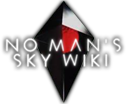| The subject of this article is from the NextGen update.
The information from this article is up-to-date as of 16 February, 2021. |
The subject of this article is from the NextGen update.
The information from this article is up-to-date as of 16 February, 2021.
The information from this article is up-to-date as of 16 February, 2021.
| This article was documented by the Galactic Hub. |
| HUB1-22A Necouvern | |
|---|---|

| |
| Galaxy | Euclid |
| Region | The Arm of Vezitinen |
| Star system | HUB1-22A Garou |
| Biome | Volcanic - Unstable |
| Weather | Lethal Ash Storms |
| Resources | Cd+, Py, Fe++ |
| Sentinels | Spread Thin |
| Flora | Limited |
| Fauna | Abundant (10) |
| Claimed by | Galactic Hub Project |
| Discovered by | JasperBeardly4 |
| Discovery platform | PS4 |
| Game Mode | Normal |
| Updated | NextGen |
HUB1-22A Necouvern is a planet in No Man's Sky.
Summary
HUB1-22A Necouvern is a planet in the HUB1-22A Garou star system in the No Man's Sky universe.
It is home to a Galactic Hub colony called New Pompeii.

|
Alias names
| PS4 | Current: | HUB1-22A Necouvern |
|---|
| PC | Other: | Space Australia |
|---|
Discovered
- Discovered and uploaded by PS4 explorer JasperBeardly4 on Aug 4, 2018
- Explored and documented by GHGS Researcher TPHaze on Oct 18, 2020
Planet type
Biome - Volcanic - Unstable
Moons
This planet has no moons.
Location
It can be found in the HUB1-22A Garou star system in the The Arm of Vezitinen region of the Galactic Hub Project, in the Euclid galaxy.
Coordinates
Glyphs
222AF9556C30222AF9556C30
Notable locations / Waypoints
Life
Fauna
- There are 10 fauna on this planet
| IMAGE | NAME | ECOSYSTEM | GENUS | HEIGHT | WEIGHT | DISCOVERED BY |
|---|---|---|---|---|---|---|
 |
L. Muskolhagium | Rare / Ground / Always Active |
Bos | 6.9 - 7.1m | 310.9 - 323.1kg | TPHaze |
Flora
| IMAGE | NAME | ELEMENTS | AGE | ROOT STRUCTURE | NUTRIENT SOURCE | NOTES | DISCOVERED BY |
|---|---|---|---|---|---|---|---|
Minerals
| IMAGE | NAME | ELEMENTS | METAL CONTENT | FORMATION PROCESS | NOTES | DISCOVERED BY |
|---|---|---|---|---|---|---|
Sentinels
The sentinels are Spread Thin on this planet and do not present an immediate threat.
Resources
The following resources can be found on this planet:
Additional Information
Explored and documented by GHGS Researcher TPHaze on Oct 17, 2020




